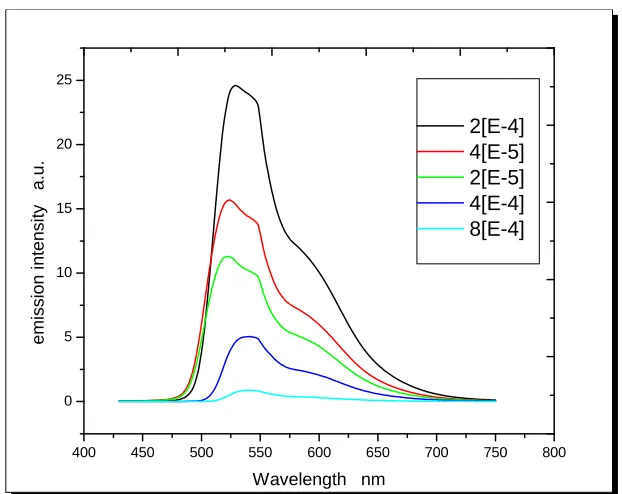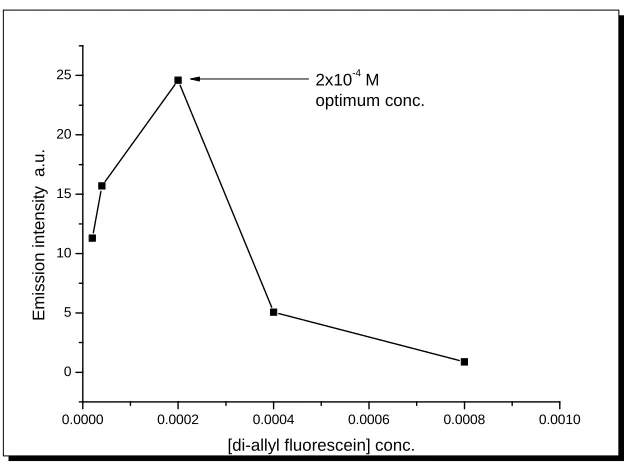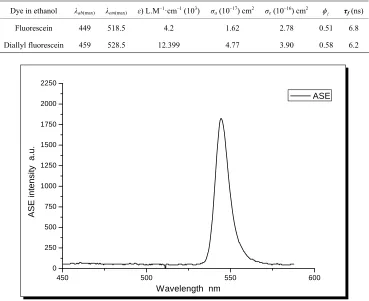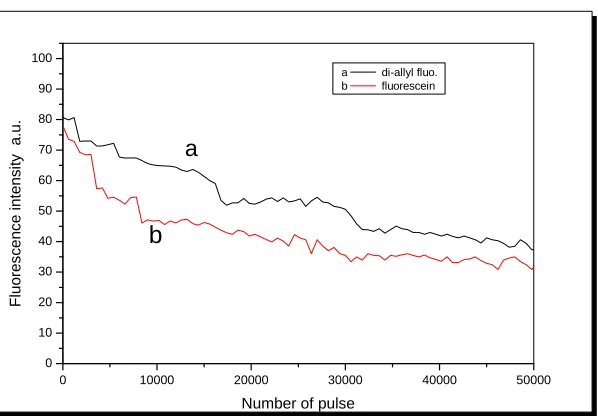Optical, Photophysical, Stability and Mirrorless Lasing
Properties of Novel Fluorescein Derivative Dye in Solution
Maram T. H. Abou-Kana
National Institute of Laser Enhanced Sciences, Cairo University, Giza, Egypt Email: mabou202@niles.edu.eg
Received August 24, 2012; revised September 25, 2012; accepted October 5,2012
ABSTRACT
Novel laser dye, allyl 2-(6-(allyloxy)-3-oxo-3H-xanthen-9-yl) benzoate [diallyl-fluorescein] has been synthesized. Its chemical structure was confirmed by 1HNMR, IR, MS and elemental analysis. Its optical properties were
experimen-tally investigated. The amplified spontaneous emission (ASE) efficiency was 0.29% in case of new dye while it was 0.23% in case of fluorescein by pumping the dye samples with a 532 nm (7 ns) pulsed Nd:YAG laser. Also, the thermal and photostability techniques confirmed the higher stability of new laser dye.
Keywords: Laser Dye; Optical Properties; Amplified Spontaneous Emission; Thermal Stability; Photostability Property
1. Introduction
Dye lasers are the most versatile class of lasers with di-verse applications in many scientific, industrial, medical and military applications, ranging from spectroscopy to potential counter measure devices. There is a growing devote concerning of dye laser and the search for par-ticular laser dyes that provide high laser damage thres- hold and high photostability. The photophysical and las- ing properties of laser dyes in liquid solutions show a strong dependence on the molecular structure of the dye [1-5]. Moreover, adequate substituent in the molecular core can alter both electronic absorption and emission maxi- mum due to change in mobility of electrons by the nature of the substituent group in the parent dye [6-11]. This structure modification may give rise to large changes in the photophysical and optical properties [12-24]. For exam-ple displacing the emission band to longer wavelengths can be achieved by: 1) attaching electron-donating group to the dye core [25]; 2) rigidifying the structure [26-28]; or 3) extending the conjugation of the chromophore [29-31]. So, lasing properties should be redetermined.
Depending upon these results and trying to find novel laser dye with high laser performance and photostability, we carried out our previous work [32,33] and are now dealing with new fluorescein derivative. The present in- vestigation deals with synthesis, chemical structure con- firmation by spectroscopic techniques, photophysical pro- perties, optical properties, stability and amplified spon- taneous emission efficiency were determined and com- pared with the parent fluorescein itself.
2. Experimental
2.1. Materials
Fluorescein purchased from Aldrich chemical company (England) has been used without further purification, allyl bromide, potassium hydroxide, Dimethyl forma-mide and conc. Sulphuric acid was purchased from Al-drich and used without further purification. Solvents for photophysical and laser studies were of spectroscopic grade (Merck, Aldrich or Sigma) and were used without purification.
2.2. Synthesis
Preparation of the new compound allyl 2-(6-(allyloxy)-3- oxo-3H-xanthen-9-yl) benzoate [diallyl-fluorescein] 2 was as follows: Fluorescein 1 (1 mmol) was dissolved in hot ethanolic KOH solution (prepared by dissolving (2 mmol) of KOH in 10 ml of absolute ethanol), and the solvent was then removed in vacuo. The remaining material was dissolved in dimethyl formamide (DMF) (10 ml) and allyl chloride (2.2 mmol) was added. The reaction mix- ture was heated under reflux for 10 min with continuous stirring. The solid obtained upon cooling and dilution with water was collected and purified by crystallization from methanol solution to give orange crystals, m.p. 148˚C - 151˚C. The schematic reaction of the preparation of new dye is shown in Scheme 1.
2.3. Measurements
O O
H O
HOOC
O
O
O O
O 1) KOH/EtOH
2) Allyl Chloride/DMF Reflux 10 min.
1 2
Scheme 1. The schematic reaction of the preparation of new dye.
dye derivative was confirmed by Perkin-Elmer CHN 240 B. Column chromatography: Basic alumina [activity B II-III (Brock-mann) ICN Biomedical for elemental ana- lysis. 1HNMR was recorded with a Bruker NMR spec-
trometer WM 300 in CDCl3 with tetramethylsilane as internal standard. Mass spectra (MS) were obtained with a Varian 311A instrument using Electron Impact (EI) technique.
2) Thermal stability of diallyl fluorescein and fluo-rescein parent were measured under atmospheric nitro-gen using Shimadzu TGA-50H. Liquid solutions of the dye in different solvents were contained in 1-cm optical path quartz cells carefully sealed to avoid solvent evapo-ration during the experiments. Absorption and excita-tion-emission spectra were measured by Camspec M501 uv-vis spectrophotometer and PF-6300 spectrofluorome-ter respectively.
3) Optimum concentration of the dye as linear fluo- rescence in ethanol was detected from its absorption and emission spectra.
4) Some important photo-physical parameters of the new di-allyl fluorescein dye were determined from its absorption and excitation-emission spectra. Fluorescence quantum yields were measured by using the optically very diluted solution (2 × 10–6 M) relative method [34,35]
with solution of fluorescein as reference in 0.1 M NaOH (φf = 0.79) [36].
5) The fluorescence lifetime (τf), were measured by using nitrogen laser (laser photonics LN1000) of pulse duration of 800 ps and wavelength 337.1 nm. The maxi-mum energy per pulse was 2 mJ. The fluorescence signal was registrated with a fast phototube (Hamamatsu R1328U-03) through optical fiber. The fast phototube (+H.V) powered by power supply at 400 V and con-nected to the 300 MHz eZ-digital oscilloscope (DS-1530) attached to the computer processing unit for processing the spectrum.
6) The amplified spontaneous emission (ASE) spec-trum and its efficiency of 2 × 10–4 M of dye in ethanol
have been measured using the experimental setup in our previous work [32]. The dye sample is pumped by 532 nm of second harmonic Nd-YAG laser (Continuum PL7010), 7 ns pulses at a repetition rate of 5 Hz. The exciting light was directed towards the surface of cell sample with a combination of concave lens (f = 10 cm)
and a cylindrical lens forming a line shape of dimension ~ 0.3 × 10 mm. The pump fluence was 71 mJ/cm2. The
pumping energy (input energy) was measured via a beam splitter (4%) and using Gentec energy meter (Model QE50). The ASE output was focused by convex lens (f = 15 cm) onto the Gentec power meter head (model XLE4). The ASE spectrum was recorded using the Oplenic spec-trophotometer which was connected to a computer unit for processing the spectrum.
7) Thermal stability of the diallyl-fluorescein and fluorescein itself were measured using Shimadzu TGA- 50H. Photo stabilities of fluorescein parent and its new derivative were measured using the above setup as a function of number of pulses ranged from (0 - 50000) pulse.
3. Results and Discussion
The chemical structure of the diallyl fluorescein dye was confirmed by 1HNMR, IR, mass spectroscopy as well as
elemental analysis. 1HNMR spectra shows that, (DMSO)
δ = 4.45 - 4.67 (m, 4H, OCH2), 5.08-6.12 (m, 6H,
CH=CH2), 6.53 - 8.29 (m, 10H, ArH’s) ppm. While
FT-IR spectra of diallyl fluorescein shows that, the ab-sence of strong absorption bands characteristic for the phenolic OH as well as the carboxylic acid OH at 3200 - 3500 and 2500 - 3400 cm–1, respectively. The IR
spec-trum revealed also strong absorption bands due to C=C stretching vibration mode at 1641 cm–1 of vinyl group;
and C=C stretching at 1596 cm–1 of phenyl group. Also
the structure of the new laser dye 2 was confirmed by the presence of the correct molecular ion peak at the mass spectrum; ms: m/z (%) 412 (M+). On the other hand,
elemental analysis was: Anal. Calcd. for C26H20O5: C,
75.72; H, 4.89. Found: C, 75.60; H, 4.50.
[image:2.595.61.287.86.153.2] [image:2.595.314.533.582.717.2]Thermal stability also measured and represented in
Figure 1. It shows that the fluorescein started
decom-posing at 200˚C and its weight losing was 88.76% up to the temperature studied (1000˚C) while diallyl fluo-rescein started decomposing at 220˚C and its weight los-ing was 77.47% up to the temperature studied (1000˚C).
Absorption and emission spectra (shown in Figures 2
and 3 respectively) of the different concentrations of the
new dye in ethanol show optimum concentration (2 × 10–4 M) at which maximum linear fluorescence was
de-tected by exciting the sample dye with 420 nm wave-length, while absorption profile was changed at concen-trations higher than that optimum concentration. Also, emission intensity decrease at concentrations higher than optimum concentration (shown in Figure 4) which may
attributed to inner filter effect or/and the formation of its dimer form. In case of fluorescein dye, its dimer form at concentration higher than 10–5 M [37].
Photophysical properties of diallyl-fluorescein in dif-ferent media polarities:
The electronic absorption and emission spectra of 2 × 10–4 M (
Figure 5) was measured at room temperature in
different solvents of different polarities [Δf] with f given by the relation [38].
200 300 400 500 600 700 800
-0.5 0.0 0.5 1.0 1.5 2.0 2.5 3.0 3.5 4.0 4.5
ab
so
rp
ti
on
i
n
ten
s
it
y a.u
.
Wavelength nm
[image:3.595.145.453.205.447.2]2[E-5]
4[E-5]
2[E-4]
4[E-4]
8[E-4]
Figure 2. Absorption spectra of different concentrations of diallyl fluorescein dye in ethano.
400 450 500 550 600 650 700 750 800
0 5 10 15 20 25
2[E-4] 4[E-5] 2[E-5] 4[E-4] 8[E-4]
emission
i
n
tensi
ty
a.u.
Wavelength nm
[image:3.595.142.453.470.717.2]0.0000 0.0002 0.0004 0.0006 0.0008 0.0010 0
5 10 15 20 25
Emi
ssi
on
in
te
n
sity a.u.
[image:4.595.141.456.81.312.2][di-allyl fluorescein] conc. 2x10-4 M optimum conc.
Figure 4. Emission intensity as a function of different dye concentrations in ethanol.
300 400 500 600 700 800
0 0 1 2 3 4 5
2[E-4] diallyl fluo. absobance emission
Wavelength nm
absorbance intensity
a.u.
0 5 10 15 20 25
Emission in
te
n
s
[image:4.595.140.455.339.586.2]ity a.u.
Figure 5. Absorption and emission spectra of 2 × 10–4 M diallyl fluorescein in ethanol.
2
2 1 1
2 1 4 2
n f
n
where (ε) is the dielectric constant and (n) is the refrac- tive index of the solvent. Table 1 summarizes some
spectral data of diallyl-fluorescein dye in different sol- vents.
The absorption of dye is not strongly affected by sol- vent polarity, whereas the small shifts in the position of
absorption spectra indicate a little change in dipole mo-ment of dye on going from ground state to excited state. The emission spectra are significantly influenced by the medium. With increasing solvent polarity, the fluores-cence maximum shifts to longer wavelengths from 497 nm in hexane [Δf = 0.091751] to 528.5 nm in ethanol [Δf =
0.41584].
Absorption cross-section σa and the emission cross-
sections σe were calculated in ethanol solution according
20 0.385 10
a
4 8π 2
e eE f cn f
where: ε is the molar extinction coefficient; λe is the
emission wavelength; n is therefractive index of the sol-vent; c is the velocity of light; f is the fluorescence quantum yield; f is the fluorescence life time; E(λ) is the normalized fluorescence spectrum since
. Also, fluorescence quantum yield “φf”
and fluorescence life time
f dE
1
of fluorescein and di- allyl fluo in ethanol were determined and summarized inTable 2.
[image:5.595.312.536.217.368.2]To examine the validity of the prepared new dye for lasing action, we measured the ASE efficiency (defined as the ratio of the energy of the dye laser output to the energy of the pump laser incident on the dye sample). The ASE as a function of wavelength was observed for 2 × 10–4 M diallyl fluorescein dye in ethanol as shown in Figure 6. The measured ASE energy versus the input
pump energies are shown in Figure 7 where the thres-
hold energy was ~ 4 mJ. The average ASE efficiency extracted from this input-output energy measurements were 0.29% in case of diallyl fluorescein while it was
0.23% in case of fluorescein.
To study the photostability of fluorescein parent and its new derivative, the fluorescence intensity was moni-tored as a function of the number of pump pulses at repe-tition rate 5 Hz, pumped energy 8 mJ/pulse. It was found that, the fluorescence intensity decreased to nearly 42% in case of fluorescein while in case of its new derivative, it decreased to nearly 46% as shown in Figure 8.
Table 1. Photophysical parameters of dye in different sol-vent polarity.
λmax
Solvent [Δf]
abs. .emi.
φf
Ethanol 0.41584 459 528.5 0.58
DMF 0.377111 457 523 0.60
Acetone 0.374482 457 522 0.53
DMSO 0.373593 456 518 0.71
Iso-propanol 0.36977 455 510 0.79
THF 0.30838 456 507.5 0.54
1,4-Dioxane 0.125892 455 502.5 0.66
Hexane 0.091751 454 497 0.52
Table 2. Maximum wavelength of absorption “λab(max)” and emission “λem(max)”; molecular extinction coefficient “ε”; cross-sections of absorption “σa”, and emission “σe”; fluorescence quantum yield “φf” and fluorescence life time τf of fluo-rescein and diallyl fluo in ethanol.
Dye in ethanol λab(max) λem(max) ε) L.M–1·cm–1 (103) σa(10–17) cm2 σe (10–16) cm2 f τf (ns)
Fluorescein 449 518.5 4.2 1.62 2.78 0.51 6.8
Diallyl fluorescein 459 528.5 12.399 4.77 3.90 0.58 6.2
450 500 550 600
0 250 500 750 1000 1250 1500 1750 2000 2250
ASE i
n
ten
s
it
y a.u
.
Wavelength nm
[image:5.595.114.483.415.716.2]ASE
0 5 10 15 20 25 0
1 2 3 4 5 6 7 8
O
u
tput
ene
rgy
m
icroJ
[image:6.595.143.455.81.306.2]Input energy mJ di-allyl fluo. fluorescein
Figure 7. ASE efficiency of diallyl fluorescein and fluorescein in ethanol.
0 10000 20000 30000 40000 50000
0 10 20 30 40 50 60 70 80 90 100
b
a
F
luores
cenc
e i
nt
ensi
ty
a.u.
Number of pulse
a di-allyl fluo. b fluorescein
Figure 8. Fluorescence intensity as a function of the number of pumping pulses at repetition rate 5 Hz and pumping power 8 mJ of 532 nm Nd-YAG laser.
4. Conclusion
In this work, we reported efficient laser operation from novel synthesized diallyl derivative of fluorescein. Electro- nic absorption, emission and fluorescence quantum yield in different solvents were measured. The solvent polarity and viscosity have great effect on tunability properties of new dye. Absorption cross section, emission cross sec-tion and fluorescence lifetime of the new dye were inves-tigated and compared with that of fluorescein itself. Un-der the same experimental condition, the ASE efficiency was 0.29% in case of new dye while it was 0.23% in case of fluorescein dye with threshold energy of the order
of about 4 mJ. Also, thermal stability and photostability measurements confirmed the higher stability of new flu- orescein derivative returns.
REFERENCES
[1] M. A. lvarez, F. Amat-Guerri, A. Costela, I. Garcıa-Mo- reno, M. Liras and R. Sastre,“Laser Emission from Mix- tures of Dipyrromethene Dyes in Liquid Solution and in Solid Polymeric Matrices,” Optics Communications, Vol. 267, No. 2, 2006, pp. 469-479.
doi:10.1016/j.optcom.2006.06.059
[image:6.595.153.452.330.538.2]Femtosecond ArF Laser Source,” Optics Letters, Vol. 19, No. 20, 1994, pp. 1639-1641.
doi:10.1364/OL.19.001639
[3] F. L. Arbeloa, T. L. Arbeloa, I. L. Arbeloa, I. García-Mo- reno, A. Costela, R. Sastre and F. Amat-Guerri, “Correla- tions between Photophysics and Lasing Properties of Di- pyrromethene—BF2 Dyes in Solution,” Chemical Physics Letters, Vol. 299, No. 3-4, 1999, pp. 315-321.
doi:10.1016/S0009-2614(98)01281-0
[4] J. H. Boyer, A. Haag, M.-L. Soong, K. Thangaraj and T. G. Pavlopoulos, “First-Order Sources in First-Order Sys- tems: Second-Order Correlations: Errata,” Applied Optics, Vol. 30, No. 27, 1991, p. 3788.
doi:10.1364/AO.30.003788
[5] J. H. Boyer, A. Haag, G. Sathyamoorthi, M.-L. Soong, K. Thangaraj and T. G. Pavlopoulos, “Pyrromethene—BF2 Complexes as Laser Dyes,” Heteroatom Chemistry, Vol. 4, 1993, pp. 39-49. doi:10.1002/hc.520040107
[6] S. A. Azim, S. M. Al-Hazmy, E. M. Ebeid and S. A. El-Daly, “A New Coumarin Laser Dye 3-(benzothiazol- 2-yl)-7-hydroxycoumarin,” Optics & Laser Technology, Vol. 37, No. 3, 2005, pp. 245-249.
doi:10.1016/j.optlastec.2004.04.003
[7] M. R. Padlye, T. S. Varadarian and A. V. Deshande, “Some New Laser Dyes—Solvent Effect on QE and Las- ing Action,” Spectroscopy Letters: An International Jour- nal for Rapid Communication, Vol. 15, No. 8, 1982, pp. 597-608. doi:10.1080/00387018208068016
[8] V. Masilamani and B. M. Sivaram, “The Laser Gain Cha- racteristics of Some Substituted Coumarins,” Journal of Luminescence,Vol. 27, No. 2, 1982, pp. 137-145.
doi:10.1016/0022-2313(82)90015-1
[9] R. Giri, S. S. Rathi, M. K. Machwe and V. S. Murti, “Ef- fect of Substituents on the Fluorescence and Absorption Spectra of Coumarins,” Spectrochimica Acta Part A: Mo- lecular Spectroscopy, Vol. 44, No. 8, 1988, pp. 805-807.
doi:10.1016/0584-8539(88)80146-6
[10] A. Ramalingam, P. K. Palanisomy, V. Masilamani and B. M. Sivaram, “Dual Amplified Spontaneous Emission from 7-amino-4-methyl Coumarin Dye,” Journal of Photo- chemistry and Photobiology A: Chemistry, Vol. 49, No. 1-2, 1989, pp. 89-96.
doi:10.1016/1010-6030(89) 87108-4
[11] S. A. Al-Hazmy, K. N. Kassab, S. A. El-Daly and E. M. Ebeid, “Spectral Properties of (5-Phenyl-1,3,4-Oxadiazol- 2-yl)-7-Hydroxycoumarin (POHC),” Spectrochimica Acta Part A: Molecular and Biomolecular Spectroscopy, Vol. 56, No. 9, 2000, pp. 1773-1780.
doi:10.1016/S1386-1425(00)00231-6
[12] A. Costela, I. García-Moreno, M. Pintado-Sierra, F. Amat- Guerri, M. Liras, R. Sastre, F. L. Arbeloa, J. B. Prieto and I. L. Arbeloa, “New Laser Dye Based on the 3-Styryl Ana- log of the BODIPY dye PM567,” Journal of Photochem- istry and Photobiology A: Chemistry, Vol. 198, No. 2-3, 2008, pp. 192-199.
doi:10.1016/j.jphotochem.2008.03.010,
[13] R. Ziessel, C. Goze, G. Ulrich, M. Cesario, P. Retailleau, A. Harriman and J. P. Rostron, “Intramolecular Energy Transfer in Pyrene—Bodipy Molecular Dyads and Triads,”
Chemistry: A European Journal, Vol. 11, No. 24, 2005, pp. 7366-7378. doi:10.1002/chem.200500373
[14] M. Baruah, W. Quin, R. A. L. Vallee, D. Beljonne, T. Ro- hand, W. Dehaen and N. Boens, “A Highly Potassium- Selective Ratiometric Fluorescent Indicator Based on BODIPY Azacrown Ether Excitable with Visible Light,” Organic Letters,Vol.7, No. 20, 2005, pp. 4377-4380.
doi:10.1021/ol051603o
[15] Z. Dost, S. Atildan and E. U. Akkaya, “Distyryl-Boradi- Azaindacenes: Facile Synthesis of Novel near IR Emit- ting Fluorophores,” Tetrahedron, Vol. 62, No. 36, 2006, pp. 8484-8488. doi:10.1016/j.tet.2006.06.082
[16] T. Rohand, M. Baruah, W. Quin, N. Boens and W. De- haen, “Functionalisation of Fluorescent BODIPY Dyes by Nucleophilic Substitution,” Chemical Communications, Vol. 42, No. 3, 2006, pp. 266-268. doi:10.1039/b512756d
[17] A. Coskun, E. Deniz and E. U. Akkaya, “Effective PET and ICT Switching of Boradiazaindacene Emission: A Unimolecular, Emission-Mode, Molecular Half-Subtrac- tor with Reconfigurable Logic Gates,” Organic Letters, Vol. 7, No. 23, 2005, pp. 5187-5189.
doi:10.1021/ol052020h
[18] N. Saki, T. Dinic and E. U. Akkaya, “Excimer Emission and Energy Transfer in Cofacial Boradiazaindacene (BODIPY) Dimers Built on a Xanthene Scaffold,” Tetra- hedron,Vol. 62, No. 11, 2006, pp. 2721-2725.
doi:10.1016/j.tet.2005.12.021
[19] A. Costela, I. García-Moreno, C. Go´mez, F. Amat-Guerri and R. Sastre, “Efficient and Stable Dye Laser Action from Modified Dipyrromethene BF2 Complexes,” Applied Phy- sics Letters, Vol. 79. No. 3, 2001, pp. 305-307.
doi:10.1063/1.1385185
[20] A. Costela, I. García-Moreno, C. Gomez, R. Sastre, F. Amat-Guerri, M. Liras, F. L. Arbeloa, J. B. Prieto and I. L. Arbeloa, “Photophysical and Lasing Properties of New Ana- logs of the Boron—Dipyrromethene Laser Dye PM567 in Liquid Solution,” The Journal of Physical Chemistry A, Vol.106, No. 34, 2002, pp. 7736-7742.
doi:10.1021/jp0209897
[21] A. Costela, I. García-Moreno, C. Gomez, F. Amat-Guerri, M. Liras and R. Sastre, “Efficient and Highly Photostable Solid-State Dye Lasers Based on Modified Dipyrrome- thene BF2 Complexes Incorporated into Solid Matrices of Poly(Methyl Methacrylate),” Applied Physics B, Vol. 76, No. 4, 2003, pp. 365-369.
doi:10.1007/s00340-003-1139-1
[22] F. L. Arbeloa, J. B. Prieto, I. L. Arbeloa, A. Costela, I. García-Moreno, C. Gomez, F. Amat-Guerri, M. Liras and R. Sastre, “Photophysical and Lasing Properties of New Analogs of the Boro—Dipyrromethene Laser Dye Pyrrome- thene 567 Incorporated into or Covalently Bounded to So- lid Matrices of Poly(methyl methacrylate),” Photochemistry and Photobiology, Vol. 78, No. 1, 2003, pp. 30-36.
doi:10.1562/0031-8655
16, 2004, pp. 3315-3323. doi:10.1021/jp0312464
[24] M. Alvarez, F. Amat-Guerri, A. Costela, I. García-Moreno, C. Gomez, M. Liras and R. Sastre, “Linear and Cross- Linked Polymeric Solid-State Dye Lasers Based on 8-Sub- stituted Alkyl Analogues of Pyrromethene 567,” Applied Physics B, Vol. 80, No. 8, 2005, pp. 993-1006.
doi:10.1007/s00340-005-1833-2
[25] A. Burghart, H. Kim, M. B. Welch, L. H. Thoresen, J. Reibenspies and K. Burgess, “3,5-Diaryl-4,4-Difluoro-4- Bora-3a,4a-Diaza-s-Indacene (BODIPY) Dyes: Synthesis, Spectroscopic, Electrochemical, and Structural Proper- ties,” Organic Chemistry,Vol. 64, No. 21, 1999, pp. 7813- 7819. doi:10.1021/jo990796o
[26] J. Chen, A. Burghart, A. Derecskei-Kovacs and K. Bur-gess, “4,4-Difluoro-4-Bora-3a,4a-Diaza-s-Indacene (BODIPY) Dyes Modified for Extended Conjugation and Restricted Bond Rotations,” The Journal of Organic Chemistry, Vol. 65, No. 10, 2000, pp. 2900-2906. doi:10.1021/jo991927o
[27] H. Kim, A. Burghart, M. B.Welch, J. Reibenspies and K. Burgess, “Synthesis and Spectroscopic Properties of a New 4-Bora-3a,4a-Diaza-s-Indacene (BODIPY®) Dye,” Che- mistry Communications, Vol. 35, No. 18, 1999, pp. 1889- 1890. doi:10.1039/a905739k
[28] J. Chen, J. Reibenspies, A. Derecskei-Kovacs and K. Bur- gess, “Through-Space 13C-19F Coupling Can Reveal Con- formations of Modified BODIPY Dyes,” Chemistry Com- munications, Vol. 35, No. 24, 1999, pp. 2501-2502.
doi:10.1039/a907559c
[29] K. Rurack, M. Kollmannberger and J. Daub, “A Highly Efficient Sensor Molecule Emitting in the Near Infrared (NIR): 3,5-distyryl-8-(p-dimethylaminophenyl) Difluo-robo- radiaza-s-indacene,” New Journal of Chemistry, Vol. 25, No. 2, 2001, pp. 289-292. doi:10.1039/b007379m
[30] K. Rurack, M. Kollmannsberger and J. Daub, “Molecular Switching in the Near Infrared (NIR) with a Functiona- lized Boronz—Dipyrromethene Dye,” Angewandte Che- mie International Edition, Vol. 40, No. 2, 2001, pp. 385- 387.
[31] W. Zhao and E. M. Carreira, “Conformationally Restricted Aza-Bodipy: A Highly Fluorescent, Stable, Near-Infrared Ab- sorbing Dye,” Angewandte Chemie International Edi- tion, Vol. 44, No. 11, 2005, pp. 1677-1679.
doi:10.1002/anie.200461868
[32] H. A. S. Al-Shamiri, M. T. H. Abou Kana, I. M. Azzouz and A. H. M. Elwahy, “Photo-Physical Properties and Amplified Spontaneous Emission of a New Derivative of Fluorescein,” Optics Communications, Vol. 283, No. 7, 2010, pp. 1438-1444. doi:10.1016/j.optcom.2009.12.028
[33] M. T. H. A. Kana, H. A. S. Al-Shamiri, I. M. Azzouz and A. H. M. Elwahy, “Spectroscopic Properties and Ampli- fied Spontaneous Emission of a New Derivative of Fluo- rescein,” Applied Physics B, Vol. 88, No. 4, 2007, pp. 575-580. doi:10.1007/s00340-007-2727-2
[34] J. V. Morris, M. A. Mahaney and J. R. Huber, “Fluores- cence Quantum Yield Determinations. 9,10-Diphenylanth- racene as a Reference Standard in Different Solvents,” TheJournal of Physical Chemistry, Vol. 80, No. 9, 1976, pp. 969-974. doi:10.1021/j100550a010
[35] J. N. Demas and G. A. Crosby, “Measurement of Photo- luminescence Quantum Yields. Review,” The Journal of Physical Chemistry, Vol. 75, No. 8, 1971, pp. 991-1024.
doi:10.1021/j100678a001
[36] J. Q. Umberger and V. K. LaMer, “The Kinetics of Diffu- sion Controlled Molecular and Ionic Reactions in Solu- tion as Determined by Measurements of the Quenching of Fluorescence,” Journal of American Chemical Society, Vol. 67, No. 7, 1945, pp. 1099-1109.
doi:10.1021/ja01223a023
[37] S. Speiser and F. L. Chisena, “Optical Bistability in Fluo- rescein Dye,” Applied Physics B, Vol. 45, No. 3, 1988, pp. 137-144. doi:10.1007/BF00695282
[38] T. D. Z. Atvars, C. A. Bortolato and D. D. Bruneli, “Elec- tronic Absorption and Fluorescence Spectra of Xanthene dyes in Polymers,” Journal of Photochemistry and Photo- biology A: Chemistry, Vol. 68, No. 1, 1991, pp. 41-50.
doi:10.1016/1010-6030(92)85016-N
[39] B. B. Raju and T. S. Varadrajan, “Photophysical Proper- ties and Energy Transfer Dye Laser Characteristics of 7-Diethylamino-3-Heteroaryl Coumarin in Solution,” Laser Chemistry,Vol. 16, No. 2, 1995, pp. 109-120.
doi:10.1155/1995/51920




